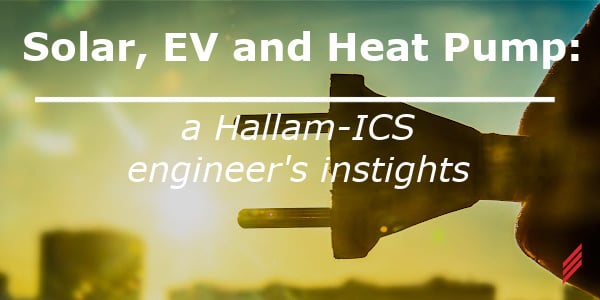Solar, EV, and Heat Pump: A Hallam-ICS Engineer’s Insights
by Dan Zang on Sep 4, 2025 10:30:00 AM

This is a follow up on my blog, Everything You Need to Know About Residential Solar Panel Installation. As mentioned in my previous post, Hallam-ICS does not sell solar panels or other associated products.
I’m not an expert on any of these products, but being an engineer and analytical in nature, I feel that I can offer some commonsense information that might be of value that other articles might overlook.
A Brief History
In October of 2022, I had a 7.2 kW solar panel system installed at my home. The goal was to offset my home’s electrical usage by installing solar panels. At the time, there were government and other incentives in place to help make this financially viable option. Please note that my home uses LP Gas for area heating and domestic hot water as well as LP Gas for the clothes dryer and kitchen stove.
Green Mountain Power provides me with credit for any excess power produced by the solar panels. (Referred to as net metering). The credit is then used during the winter months when solar production is limited. At the time, our cost for the power consumed by our home from the utility company was 0.19 $/kWh. The GMP provided a credit of 0.17$ / kWh for the power sent back to them from our solar panels.
The terms of the solar loan payment are 1.99% for a 15-year fixed rate loan. Our payment is roughly $120/mo. which matched my monthly electrical bill, so basically a wash.
So, How did the Solar Work Out?
Once the energy credits with Green Mountain Power accumulated, our monthly electric bill was roughly $25 per month. The $25 consisted of basic fees that the utility requires, and we essentially had no power usage costs. All good.
Looking back at 2023 and 2024, our solar panels produced more power than our house consumed. The power information below is expressed in megawatt hours (MWh) or millions of watts per hour.
2023 produced: 6.5 MWh and consumed 5.6 MWh.
2024 produced: 6.6 MWh and consumed 6.2 MWh.
The 2023 values are a more accurate representation of our regular energy usage. In December of 2024, our gas furnace failed. Green Mountain Power provides credits at $0.17/kWh and our furnace failure increased consumption to 6.2 MWh due to three 1,500 W heaters. This had a significant impact on our electrical usage for that year.
Our Net Metering agreement stipulates that any excess power produced that is not used within one year is forfeited to the utility company. Knowing that our solar panel production exceeds our home’s energy consumption, we knew we had extra energy we could use elsewhere. We moved forward with the purchase of an EV (electric vehicle) and a Heat Pump.
The Next Step; An EV. Some Things I Learned Along the Way
In 2024, we needed a new all-wheel drive vehicle. We chose to purchase an EV.
We’ve been asked many questions about owning an EV. Here are a few items that I’d like to share as a first time EV purchaser and user.
- EV Range: The US Department of Energy (https://www.fueleconomy.gov/feg/findacar.shtml) publishes energy range information for almost all vehicles. Each vehicle is assessed under similar conditions. The web site is a helpful guide when comparing the energy usage of different vehicles. The reason I say “guide” is because the testing guidelines and real-world use are different for each person. Examples:
- Some people may only drive in the city while others drive mainly on highways.
- Have an aggressive driving style.
- The amount of air conditioning used.
- Cold weather operation.
Due to the above, your milage may vary from published values.
- If an EV states that it has a mileage range of 300-miles, it might have this capability, but I’d suggest assuming it’s with a 100% fully charged battery operated down to zero. Many EV manufacturers recommend charging the battery to 80% and using the battery down to 20% before recharging. This helps with battery longevity. (This 80% to 20% rule will vary by EV model and manufacturer).
In our case, we don’t have the 300-mile range if we are preserving the cars’ battery for long life. We have 60%, or roughly 180 miles. The information I’ve read is that fully charging the battery to 100% for occasional trips should not have a detrimental effect on the battery’s life. The range with a battery charged to 100% and used down to 20% results in a range of approximately 240 miles.
- Range Anxiety: I think it’s very important to understand the daily usage of our EV. I estimate that 95% of the EV usage is traveling to work, shopping and for local outings, roughly 55 to 75 miles a day. This is well within the 180-mile range that helps preserve EV’s battery life.
- Cold weather does affect the EV range, and I live in the northeast. As an example, my one-way 27-mile trip to work in the winter would use 13% of the EV’s battery capacity. In the summer months, the same trip uses approximately 11% of battery usage.
The EV we own has settings to help offset the cold weather. A timer can be set to “pre-heat” the cars battery before I leave for work. This same timer can be set up to preheat the EV’s interior, the car seats and steering wheel.
- Our utility company, Green Mountain Power, provides the EV charger free of charge and provides an allowance to pay for an electrician to install it. At our home, the power company offers a reduced rate for Level 2, off-peak EV charging (9:00 pm to 12:00 noon). The off-peak cost is 0.15$/kWh and our regular usage rate is 0.19 $/kWh. Level 2 public charging costs vary but are usually around 0.25 $/kWh. Public fast DC Level 3 charging costs also vary and are generally more expensive. I’ve seen rates between 0.40 to a ridiculous rate as high as 0.91 $/kWh. For our family, it’s more cost effective and convenient to plug our EV in at home and let it charge overnight during off peak hours.
- Another item I discovered is when your public charging secession is finished, you will want to unplug the EV and move it to a non-charger parking space. Many EV charging stations will charge a per minute fee for EV that’s finished charging but still plugged in.
- In my opinion the reduced cost of home charging verses public charging is very important for non-homeowners to be aware of. The higher costs of public charging at some locations may equal or be more expensive than the cost of filling an internal combustion engine (ICE) type vehicle up with gasoline.
- Adding an EV charger to your home should be completed by a licensed electrician. They can evaluate your home’s electrical system to confirm if it has adequate capacity. Our EV charger’s electrical power input is adjustable from 30 amps to 60 amps. 60 amps will provide faster charging. In our case, we charge overnight so the faster charging isn’t a requirement. This input power flexibility can be helpful to the electrician when evaluating your electrical panel.
- If the electrician determines that the electrical panel isn’t suitable for the installation of an EV charger, there is an option. Some utility companies allow a metering accessory to be added for an EV battery charger connection. Basically, the utility meter is removed, the EV utility meter adapter is installed, and the utility meter is replaced. ConnectDER is a manufacturer of this type of adapter. I’m not endorsing this company, but presenting an option if an electrician determines the electrical panel is not suitable for a charger installation. As always, a licensed electrician and proper approvals are a must.
- There is a setting to keep the EV’s interior at a reasonable temperature, whether the EV is occupied or not. I was unaware of this for months but discovered a fan operating when the EV was unoccupied during a summer heatwave. Turning this setting “off” resulted in roughly 2% additional battery capacity at the end of my workday commute. Though it is a nice option, I prefer to leave my windows open, “a crack” during the day and have the EV cool or heat the interior when its occupied. This might explain why some people have experienced a low battery level when returning to their EV after sitting in a parking lot for a long time.
- In our case, the EV battery has a warranty of 8 years or 120,000 miles whichever comes first and is transferable. This warranty assumes the battery will maintain at least 70% of capacity within that time frame or mileage. I do not anticipate the battery to completely stop working but I’m assuming the battery range will reduce over time.
- Weight and tire wear. I’ve heard claims of excessive tire ware due to the battery weight and the quick acceleration that an EV is capable of. I own a Dodge Challenger that weighs 4,200 lbs. and the new EV weighs 4,400 lbs. In my case, I don’t see a significant weight difference between the two vehicles. Regarding EV’s quick acceleration capabilities, I have not seen any noticeable increase in tire ware. The EV I own has an adjustment for its acceleration and braking. I prefer to have my EV set to “chill”, which lessens the sensitivity of the pedal response. In my opinion, the Dodge and the EV can both experience excessive tire ware. It really depends on how aggressively my right foot is used.
The Big Question, Solar and the EV
We knew that our existing 7.2 kW solar panels would not be able to keep up with both our house load and the new EV. Our solar panel provider mentioned that it would take at least eight 400-watt solar panels to just power an EV.
Interestingly enough, on a clear, sunny summer day, our solar panels provide enough power for the house and to recharge the EV after a day’s usage. Unfortunately, not every day in Vermont is a clear, long sunny summer day.
EV Power Cost Verses Gasoline Costs
What does the EV cost to operate? This is probably one of the most commonly asked questions.
Our electrical bill itemizes the off-peak electrical power to charge the EV. (This power is invoiced separately at the lower rate of 0.15 $/kWh). Our usage cost averages between $75 to $85 per month. I generally drive 325 miles a week or 1,300 miles a month. This equates to $0.06/mile.
If an internal combustion engine car (ICE) gets 25 miles to the gallon, and a gallon of gas cost of $3.25 per gallon, the fuel cost is $3.25 to go 25 miles.
Our EV energy cost is roughly $0.06/mile. To go 25 miles our EV would cost $1.54 versus $3.25 for gas in an ICE vehicle. There are many variables here, the cost of gas, the ICE car miles per gallon, the electrical energy cost, and cold weather performance just to name a few. The example above is for reference and uses our vehicles and energy costs at the time of this writing.
An item to note is that EVs don’t require oil changes, exhaust system work, spark plugs, and overall, an EV has fewer moving parts to fail. Less moving parts means less items to maintain.
Overall, we are happy with the EV purchase. It does take some time to get used to though. As with anything new, patience is a good thing.
More Solar Please; Well Maybe
I received a quote to install eight new solar panels on our roof and to have them connected to our existing solar power system. The estimated cost was $9,500 after a 30% government rebate was applied. The solar quote included a very important piece of information, the anticipated power production per year. The eight new panels’ yearly output was estimated to be 2,500 kwh. This sounds like a lot of power but when you apply our 0.19 $/kwh utility cost to that value, it’s about $475 per year. The simple payback for the $9,500 investment would be 20 years. In my opinion, the additional solar panels at this price point are not a worthwhile investment.
The 2025 tariffs will likely raise solar panel costs in the United States by an average of ten cents per watt for solar hardware. This includes an increase of 3-6 cents per watt on imported panels and another 3-5 cents per watt on balance of system components, according to Solar.com.
I’m assuming the newly implemented tariffs, and the possibility that the remaining solar roof locations are less productive are likely the main factors contributing to the poor return on investment.
Enter The Heat Pump
In December of 2024, we replaced our failed 80,000 BTU, 80% AFEU, single speed fan, LP gas furnace. The new furnace is an 80,000 BTU, 97% AFEU, variable speed fan, hot air unit. In April of 2025, we installed a 3 ton (36,000 BTU), 17.2 SEER2, variable speed heat pump. The heat pump installation was integrated into the existing furnace ductwork system.
In June of 2025, the northeast experienced a heat wave with temperatures of 100 degrees F and humidity levels of 75%. In my opinion, this was a good test for heat pump cooling capability and energy usage. Comfort wise, it was great.
The Heat Pump Energy Comparison for Cooling; To Be Fair, It’s Complicated
I used our solar panel monitoring system to provide energy information. During the summer months, the heat pump is generally switched off. If we know warmer humid weather is coming, we turn on the thermostats automatic cooling mode.
We can see when the heat pump is operating by the steady increase in energy consumption. During a recent heat wave, our power usage jumped from 1.1 kW to 3.2 kW and stayed at 3.2 kW for hours at a time. At 0.19 $/kWh the cost per hour is 0.40 $/hour.
In the past, we used three 12,000 BTU window air conditioners (AC) for an estimated total of 36,000 BTU of cooling. These three units would be set to “high” when we arrived home in the afternoon and left running until 10:00 or 11: 00 pm.
These three window AC units and the new heat pump have the same cooling output. The three window AC units have a 4.3 kWh power requirement when on the high setting. At 0.19 $/kW it costs 0.82 $/hour. Using this comparison, the window AC units have double the operational cost.
Why do I say it’s complicated? It appears obvious the heat pump is less expensive to operate. This is true, but I feel there are other important considerations as well.
- We don’t operate the heat pump and our three window air conditioners the same way. During warm weather conditions the heat pump is set to automatic. This provides slow continuous cooling using the variable speed blower and heat pump compressor. The window AC units are set to high and are turned on and off manually.
- Heat pump installations are a lot more expensive than three single window AC units. Three higher output window AC units would cost roughly $1,500. A new heat pump installation may cost $5,000.
- In our case, the heat pump provides the whole house with cooling and heating through existing ductwork. The window AC units just provide cooling in the rooms in which they are placed.
- Some heat pump installations are like a window air conditioner and only cool a room or a specific area.
- Window AC units are bulky and can be heavy. The annual spring window AC unit installation and fall removal aren’t one of my favorite tasks.
- How often is AC really needed where you live? We use our AC units a few weeks a year.
I’m not advocating for one type of system cooling over the other. There are many variables that might be overlooked when comparing the two types of home cooling systems.
Heating With the Heat Pump … I’m Not Sure if it’s Cost Effective in My Case
Our neighborhood tries to purchase propane from one supplier to get a better deal. This has a significant impact on the cost of our LP Gas. We will be paying $2.06 per gallon this winter and the state average cost is presently about $3.50 per gallon.
I’m interested to see how the heat pump system works out this winter. Our low cost LP Gas combined with the very energy efficient gas furnace might be more cost effective than heating with the heat pump.
The output temperature of our new gas furnace is expected to be approximately 130 degrees F. The output temperature of our heat pump is expected to be roughly 95 degrees F. During cold weather, the heat pumps lower output temperature may have a difficult time maintaining a comfortable temperature inside our home. I’m assuming the heat pump might have to operate continuously during cold weather conditions. The LP Gas furnaces’ higher output temperature may result in more intermittent operation.
Conclusions
Solar
Our solar installation has outperformed its original design expectations. This is great news! It’s been maintenance free for the past three years. Financially, the power it produces still offsets our electrical costs for the house loads. (Not including the EV or the Heat Pump).
EV
We needed a new winter vehicle with all-wheel drive that was economical and had low maintenance costs. The EV purchasing incentives made the cost comparable to a new ICE vehicle. Most of our EV’s use is to local destinations, so range anxiety isn’t an issue. The EV’s battery warranty is for at least 8 years or 120,000 miles. The EV’s battery range will degrade over time but shouldn’t outright fail. Our power companies’ low cost, off peak, EV charging rate at home is a key factor. Overall, I think the EV was a good investment.
Heat Pump
The cooling this summer has been a welcome benefit. I don’t miss the seasonal installation and removal of the three window AC units either. The cooling energy costs are lower, but heat pumps have a high initial installation cost when compared to window AC units.
There is the use of the heat pump for a home’s central heating system to be considered. This might be a great cost saver for some, but I don’t think it is in my case. I have a low-cost LP Gas supplier and an energy efficient LP gas furnace. The cost of LP gas might increase. If it does, the heat pump may become a great inexpensive option to heat our home.
The lower air temperature of the heat pump in the cold weather might be an issue in our case. Our home is 25 years old, and the heat / cooling system relies on ductwork. The second-floor ductwork is installed in the first-floor exterior wall cavity between the wall studs. These wall cavities are not well insulated due to the duct work is in the same area. The heat pumps’ low output temperature might not be high enough to overcome the ductwork temperature losses in the first-floor exterior walls. Time will tell.
If your home isn’t well insulated and or has leaky windows, the heat pumps lower output air temperature may not be able to maintain the desired inside temperature on cold days. The ability for a heat pump to operate at low outside temperatures is important but if the heat pump can’t offset the inside area heat loss, the extra cost for a cold climate heat pump might not be worth it. I anticipate our heat pump heating use will be for the spring and fall seasons and not during the cold weather months.
Things to Think About
Your budget? Do you live in an apartment or own your own home? What part of the country do you live in? Do you drive long distances every day or just short-day trips? What are your utility costs?
This article is to try to convey my experience with solar, heat pump and EV. I think that it’s worthwhile to remember that everyone’s circumstances are different and it’s important to look at the factors in your specific circumstances.
What’s Next?
I plan on a DIY project to install a small number of ground mounted, bifacial solar panels in my backyard. I’m curious about the additional reflective solar output from snow and other surfaces. (We get snow in Vermont!). The goal is to peck away at the heat pump and EV power usage.
I hope the above information is helpful.
About the Author
Dan has been at Hallam-ICS for over 25 years. He is a lead electrical engineer on projects ranging from large SEMI conductor fabs, pharmaceutical facilities, college laboratories, talc mills, data centers and luxury condominium projects.
Read My Hallam Story
About Hallam-ICS
Hallam-ICS is an engineering and automation company that designs MEP systems for facilities and plants, engineers control and automation solutions, and ensures safety and regulatory compliance through arc flash studies, commissioning, and validation. Our offices are located in Massachusetts, Connecticut, New York, Vermont and North Carolina and our projects take us world-wide.
You May Also Like
These Related Stories

Celebrating Engineers Week: How Hallam-ICS Supports Future Engineers

How Competitive Bidding Impacts Engineering Ethics and Project Quality



No Comments Yet
Let us know what you think